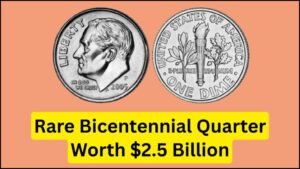Imagine fishing a penny from your pocket, glancing at it, and realizing it’s worth more than a mansion. Sounds like a dream, right? But the legendary Lincoln Wheat Penny, valued at a jaw-dropping $5.5 million, could be hiding in plain sight—maybe in your change jar or at the bottom of your purse! This iconic coin, a tiny piece of American history, has sparked a nationwide treasure hunt, turning everyday folks into eagle-eyed numismatists. Let’s dive into the thrilling story of this copper gem, why it’s so valuable, and how you might just stumble upon one.
The Fascinating History of the Lincoln Wheat Penny
A Coin Born from a Centennial Celebration
Minted from 1909 to 1958, the Lincoln Wheat Penny was introduced to celebrate Abraham Lincoln’s 100th birthday. Designed by sculptor Victor David Brenner, it was a groundbreaking moment in U.S. coinage—the first time a real person’s likeness graced a circulating coin. The obverse features Lincoln’s stoic profile, while the reverse showcases two wheat stalks framing “ONE CENT” and “UNITED STATES OF AMERICA,” giving the coin its charming “Wheat Penny” nickname. For nearly half a century, these pennies jingled in American pockets, witnessing everything from the Great Depression to World War II.
The Wartime Blunder That Created a Legend
The real magic happened in 1943, during the height of World War II. Copper was a precious wartime resource, needed for ammunition and wiring, so the U.S. Mint switched to zinc-coated steel for pennies. But here’s where fate threw a curveball: a few copper planchets from 1942 were accidentally left in the minting presses. When these were struck with 1943 dies, the result was a rare batch of bronze pennies—fewer than 20 are known to exist across the Philadelphia, Denver, and San Francisco mints. This minting mishap turned an ordinary penny into a numismatic unicorn, with one Denver-minted 1943 bronze penny fetching $1.7 million at auction in 2010 and now estimated at $5.5 million in pristine condition.
Why Is the 1943 Bronze Penny So Valuable?
A Perfect Storm of Rarity and History
The 1943 bronze penny’s value comes from a trifecta of factors: extreme rarity, historical significance, and collector frenzy. With only a handful of authentic specimens known, these coins are the Holy Grail of coin collecting. Their wartime origin adds a layer of intrigue—each penny is a tangible link to America’s WWII sacrifices. The coin’s pristine condition can also skyrocket its value, as collectors prize uncirculated examples with original luster.
Other Valuable Wheat Pennies to Watch For
While the 1943 bronze penny steals the spotlight, other Lincoln Wheat Pennies can also fetch hefty sums. The 1909-S VDB, with only 484,000 minted, can sell for up to $50,000 due to its designer’s controversial initials. The 1955 Doubled Die, with its distinct doubled lettering, can go for tens of thousands. Even the 1914-D and 1922 No D varieties are worth thousands in good condition.
How to Spot a $5.5 Million Penny
Simple Tests for Treasure Hunters
Think you’ve got a 1943 bronze penny? Here’s how to check:
- Date Check: Look for “1943” under Lincoln’s bust.
- Magnet Test: Steel pennies stick to a magnet; the rare bronze ones don’t.
- Weight Check: Bronze pennies weigh about 3.11 grams, while steel ones are lighter at 2.7 grams.
- Mint Mark: Check for a “D” (Denver) or “S” (San Francisco) under the date, as these are rarer.
Beware of fakes—some 1948 pennies have been altered to look like 1943s. Always get suspected treasures authenticated by professionals like PCGS or NGC.
Where Might You Find One?
These pennies could be anywhere—pocket change, bank rolls, estate sales, or old coin jars. Stories of valuable coins surfacing in gumball machines or inherited collections keep the dream alive. So, next time you get change, take a closer look!
| Key Lincoln Wheat Pennies | Estimated Value | Why It’s Valuable |
|---|---|---|
| 1943 Bronze Penny | Up to $5.5M | Rare minting error |
| 1909-S VDB | Up to $50K | Low mintage, initials |
| 1955 Doubled Die | Up to $25K | Visible doubling error |
| 1914-D | Up to $10K | Low mintage |
Preserving Your Potential Treasure
Found a promising penny? Handle it with care! Touch only the edges, ideally with cotton gloves, to avoid damaging the surface. Never clean it—collectors value the natural patina. Store it in an acid-free, non-PVC holder in a cool, dry place. Professional authentication is a must to confirm its value and avoid costly mistakes.
Conclusion: The Thrill of the Hunt
The $5.5 million Lincoln Wheat Penny isn’t just a coin—it’s a portal to history, a wartime fluke, and a collector’s dream. Its astronomical value proves that treasures can hide in the most ordinary places, turning a trip to the corner store into a potential jackpot. Whether you’re a seasoned numismatist or just curious, checking your change adds a spark of adventure to everyday life. So, grab that coin jar, channel your inner treasure hunter, and who knows? You might just find a piece of history worth millions.
FAQs About the Lincoln Wheat Penny
Is the $5.5 million valuation real?
While some 1943 bronze pennies have sold for over $1 million, the $5.5 million figure is an estimate for a top-grade specimen. No public record confirms this exact amount, but values continue to rise.
How can I tell if my 1943 penny is bronze?
Use a magnet—if it doesn’t stick, it’s likely bronze. Confirm with a weight check (3.11 grams) and professional authentication to rule out fakes.
Are all Lincoln Wheat Pennies valuable?
Most are worth a few cents, but rare varieties like the 1943 bronze, 1909-S VDB, or 1955 Doubled Die can fetch thousands or millions, depending on condition.
Where should I look for rare pennies?
Check pocket change, bank rolls, estate sales, or old collections. Coin shows and online forums are also great for learning and finding treasures.
Can I clean my penny to increase its value?
Never clean a coin! Cleaning damages the surface and reduces value. Collectors prefer original patina, so store it properly and seek professional grading.




